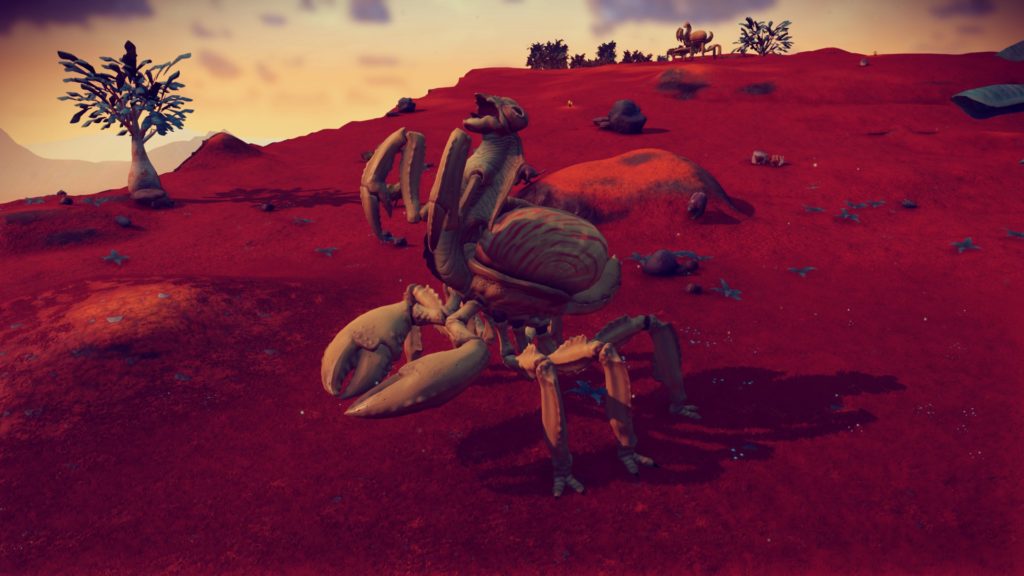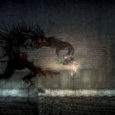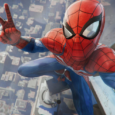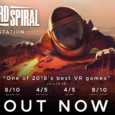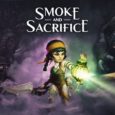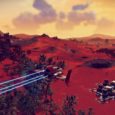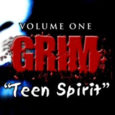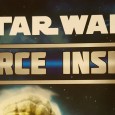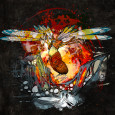It’s been a while since I’ve played No Man’s Sky and, to be fair, I thought I had completely written this game off entirely. When it first released in August of 2016, I fell deep into the hype trap, even shelling out the full $60 tag, something I am usually loath to do, and was subsequently burned. Once bitten, twice shy. After some more recent hype revolving around No Man’s Sky, though, this time with a $0 price tag since I’ve already bought into it, I decided to hop back in and check out what has really changed since launch. Find out what the ‘Next’ really means of the now titled ‘No Man’s Sky Next‘. Turns out, quite a bit has changed.
First of all, I find it weird that I’m using terminology and treating this game like it’s some sort of MMO, which now that there is some sort of real multiplayer going on I guess it is much closer to that. For all intents and purposes, though, No Man’s Sky Next still feels mostly single player. Which is fine by me. Usually, as a solo player, encountering other players in MMOs turns adversarial. We’re either fighting over the same drops, the same mobs, or fighting each other. That, as players, we’ve grown to consider this infighting ‘good, normal’ and ‘the way it should be’ is… odd. But I digress.
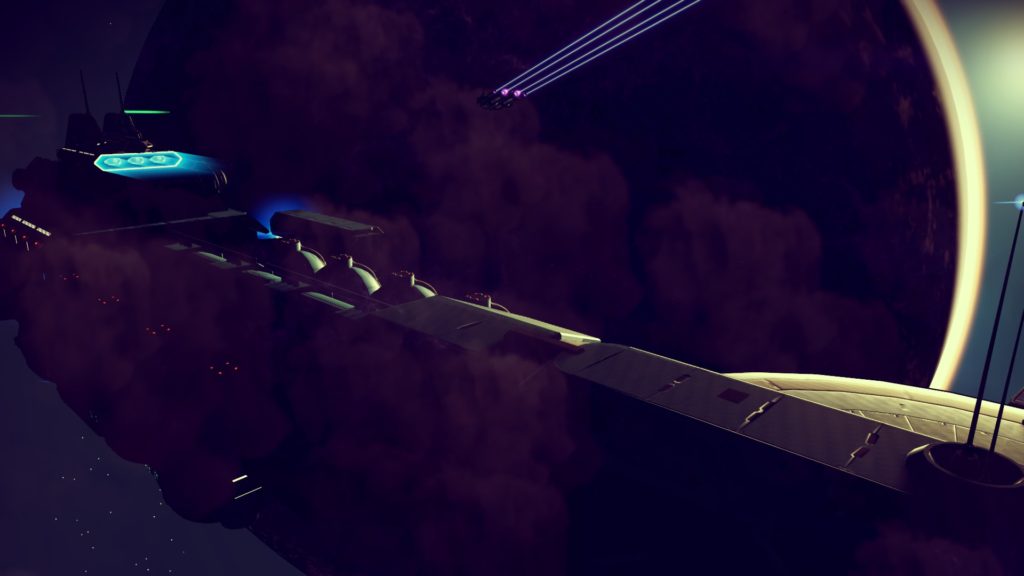
I delve back into No Man’s Sky Next after not touching it since release to see what has changed and if it’s worth playing again.
I remember when No Man’s Sky launched it felt like a wide ocean of content that was only a puddle deep. Everything was large and grand, but nothing felt important. There was no weight. Upgrades were acquired almost by accident and the primary focus was exploration… of similar, not-that-exciting locations. You could complete 99% of the game by just staying on the same planet you started on.
Now? Well, I’m not *entirely sold that No Man’s Sky Next is monumentally different, but it does feel a lot better. The focus has absolutely changed. Now, the focus is about building up your properties, your freighter fleet and your base, and completing the story missions. Your time spent on planets is transitory, hitting up only the points of interest you need to, and moving on. Which is good, because the less you see and pay attention to the procedural generation, the better. There was just not enough difference in the generation before. Now, it just feels… better. Planets feel more varied and look more populated. There’s more variety. I mean, there could always be even more variety in a game like this, but you don’t see the man-behind-the-curtain as much as you did two years ago.
Upgrades, too, seem to be made more from progress than from randomness, which is a much better feeling than just stumbling across the best weapon/ships in the game. That random big find is still included, too, though, but now instead of finding a big new ship, you now find a big *broken* ship that you need to spend a good chunk of time and resources fixing.
Again, it feels productive, not accidental. This is good.
Also, we need to talk about the screenshot capabilities. They are, hands down, the best screenshot options I have ever seen in any game. Period. And I consider myself a screenshot aficionado, so I don’t say this lightly.
At any time you can pause the game to take a screenshot. When you do, you can move the camera to any position around your character to take it, within a large distance. On top of that, if the lighting isn’t right, you can change the time of day and the position of the sun. You can add/remove clouds, change the depth of field, and even add an Instagram-like filter on top of all that. For real, all other games need to take a page from No Man’s Sky’s screenshot book. Screenshots are your players methods of advertising your game for you, and having a system like this only helps you.
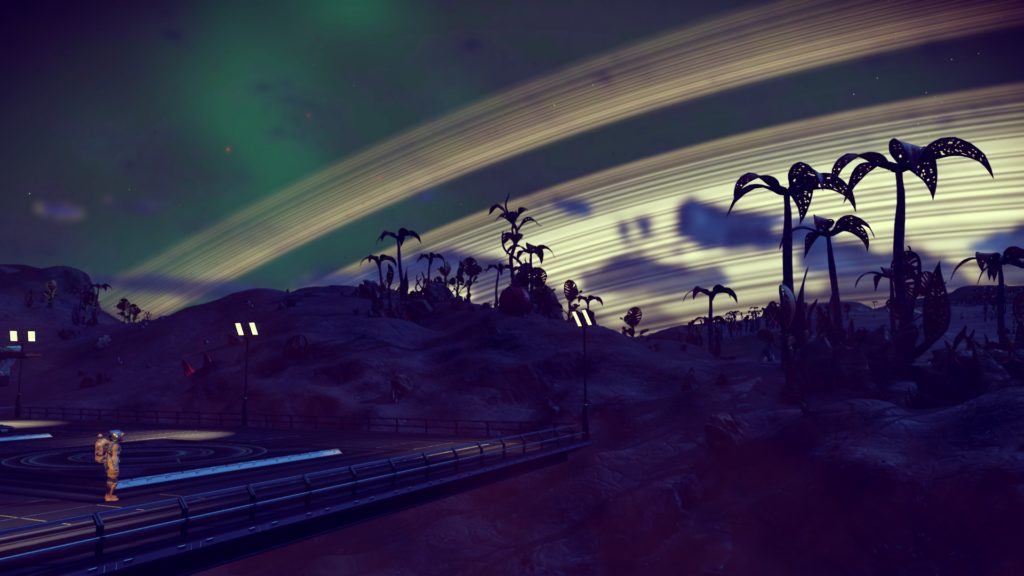
The Rings at Night! Glow Big and Bright! *clap clap clap clap* Deep In the Heart of… of… wherever this is.
So will I keep it up? No, of course not. I’m a rambling gamer and will pass quickly from game to game as my whim takes me. However, with No Man’s Sky Next focus having changed to one that feels purposeful instead of accidental, I’m a lot more apt to keep it going. Plus, the entire game fits into only a 10 GB footprint, which is efficient and impressive as anything.
It currently is still sitting at $60, though, which I wouldn’t say feels entirely worth it, but if it falls back down to $30, or even $40, I wouldn’t hesitate to suggest snapping it up. Have you hopped back into No Man’s Sky Next as well? Let us know on Twitter @SubCutured!
P.S. – If you’re looking for a good planet to settle down on, I highly suggest planet Ocho II in the Mucalls system. Red grass, bright sun, abundant resources, and a pleasant temperature all year long. Nice place to vacation. Just don’t murder me, okay?
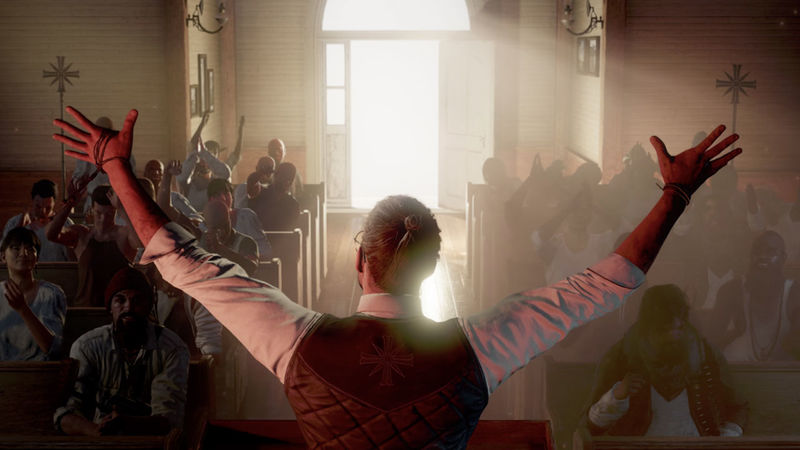
The Far Cry series has been going strong since 2004. It has gone through some changes over the years, but finally hit a really well working formula with the 2012 entry, Far Cry 3. With Far Cry 5 now out, in a Montana setting and a similar formula, does it do enough different to keep players engaged?
Far Cry has taken us to many different places, like the islands of Micronesia, Africa, it has given us animal powers, we’ve checked out some Pacific islands, headed to the Himalayas, and it has even brought us back in time to the Stone Age. Heck, the series has even taken us to a 80s themed future where you kill giant dragons. The Far Cry series does not hold back when it is picking its setting.
Hearing that Far Cry 5 would be set in the United States in the state of Montana was surprising, and for a lot of people not in a good way. How do we go from so many exotic locations, to just some random midwestern state? Well, I am happy to say that these people are just plain wrong and the setting is just as engaging as previous entries. Montana is a beautiful sate, and the development teams at Ubisoft Montreal and Ubisoft Toronto put so many interesting locations and things to do that I never felt bored.
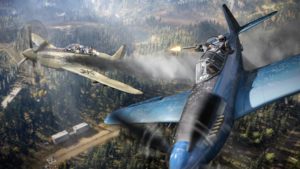 The setting brings more than just pretty trees, beautiful rivers, and mountains. We also get a healthy number of vehicles. In past games, you are usually driving some old and decrepit vehicles, but in Far Cry 5 you are behind the wheel of weaponized eighteen wheelers, trucks, and cars that you would normally see on the roads of America. If ground based traversing is not your style, then there is a large assortment of helicopter sand planes to fly, a fist for the series if you don’t count the gyro-copter in Far Cry 4. Take your trek by boat if you need to as well! Parachuting and wingsuiting are still around and as fun as ever. You are not without an assortment of ways to get across the map in any way you see fit.
The setting brings more than just pretty trees, beautiful rivers, and mountains. We also get a healthy number of vehicles. In past games, you are usually driving some old and decrepit vehicles, but in Far Cry 5 you are behind the wheel of weaponized eighteen wheelers, trucks, and cars that you would normally see on the roads of America. If ground based traversing is not your style, then there is a large assortment of helicopter sand planes to fly, a fist for the series if you don’t count the gyro-copter in Far Cry 4. Take your trek by boat if you need to as well! Parachuting and wingsuiting are still around and as fun as ever. You are not without an assortment of ways to get across the map in any way you see fit.
This time around, the player is fighting a religious cult. Many people assumed that the development team was trying to make a statement in a post-Trump America, but in my time with the game, I noticed that they main focus was creating a fun time rather than attempting to make any political or righteous proclamation via their game’s story. While it would have been interesting to see the game plant it’s feet into the ground with a statement, it was very refreshing to not have them do that, as we get plenty of politics out here in the real world. That is not to say that politics have no business in video games, but rather it was refreshing to see them not take a stance and focus on why we play games, escapism and fun. One thing is for sure, killing cultists IS fun, and our main bad guy, The Father, is very interesting. He makes quite the impression in the first moments of the game. Nobody will ever be as memorable as Vaas, but The Father holds his own in a series with pretty memorable villains.
 The gameplay is solid, and upgrading and equipping the right loadout is a fun feedback loop. To help in the carnage you now have a gun for hire mechanic. Across the game map are random NPCs and fully fleshed out characters that you can recruit to your squad. You gain the ability to have two guns for hire, which changes things up in some big ways. Need some air support? One character will follow you around in an airplane and make passes at the enemy with some killer air support. Headed into an outpost, and need a silent partner? Perhaps your dog Boomer, a cougar named Peaches, or a silent bow huntress can help! There are so many options and ways to team up and get the job done.
The gameplay is solid, and upgrading and equipping the right loadout is a fun feedback loop. To help in the carnage you now have a gun for hire mechanic. Across the game map are random NPCs and fully fleshed out characters that you can recruit to your squad. You gain the ability to have two guns for hire, which changes things up in some big ways. Need some air support? One character will follow you around in an airplane and make passes at the enemy with some killer air support. Headed into an outpost, and need a silent partner? Perhaps your dog Boomer, a cougar named Peaches, or a silent bow huntress can help! There are so many options and ways to team up and get the job done.
Now sure, a lot of this sounds like your basic, everyday Far Cry, and that’s because it is. If you were hoping for a complete overhaul of the formula, then you might be disappointed. You are still hitting points of interest, taking down outposts, doing missions and trying to take down the big bad. The way you gain access to these missions and points of interest are different though, which brings some refreshing mechanics into the mix. Gone are the radio towers that populate your map with an assortment of locales and things to do. If you want to find stuff on your map, you better do it the old fashion way and explore. You can also talk to random NPCs in the world and they will suggest places of interest for you. It is very much like The Elder Scrolls V: Skyrim in that regard. In fact this series has very much been a Skyrim with guns type of game, but now even more so.
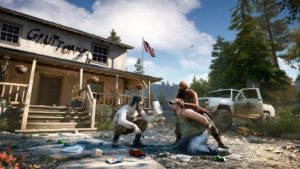 Another smaller change is the way your character progresses and grows. Experience points are no longer given with kills and liberating outposts. Instead, you get perk points for completing challenges and missions, and you use those perk points on a very standard skill tree, shaping your character into the way you want him, despite by game’s end you having enough points to spread across almost everything. No more hunting is required to further expand ammo and item slots, which to me is kind of a bummer. Hunting is almost completely unnecessary now, unless you are trying to make a quick buck on the pelts. Hunting has now been rendered to a side activity that is only good for making money.
Another smaller change is the way your character progresses and grows. Experience points are no longer given with kills and liberating outposts. Instead, you get perk points for completing challenges and missions, and you use those perk points on a very standard skill tree, shaping your character into the way you want him, despite by game’s end you having enough points to spread across almost everything. No more hunting is required to further expand ammo and item slots, which to me is kind of a bummer. Hunting is almost completely unnecessary now, unless you are trying to make a quick buck on the pelts. Hunting has now been rendered to a side activity that is only good for making money.
One last change is in mission progression. You won’t see story missions on your map regularly. Some side missions and other quests will populate on your map, but the main goal is filling up an action bar to try and get the boss of the area to come out of hiding and face you. The action bar has sections and each section filled grant you a main story mission. The thing is these missions do not populate on your map. They just happen randomly to you once the section of the gauge is filled up. Often times I would find myself driving or fighting in the world only for my screen to go blank and a story mission automatically unfolding. They give you context for why it happens so suddenly as well, so while it feels jarring it actually makes sense. One example is I was does with a drug called Bliss, and I began a very psychedelic journey that was not unlike other drug based scenes in previous games.
These changes do not make a completely new experience. They change the very standard Far Cry formula in small ways, but in the end this just feels like another Far Cry game. To be honest, I don’t think that is a bad thing. They have a very specific flavor, and what can I say I dig the taste and I don’t know if I want it or need it to change much. Enough is there to make things feel refreshing, but not too much has changed where it suffered an identity crisis. This is not a series we get yearly entries of; so I don’t think we have hit that saturation point yet with the series.
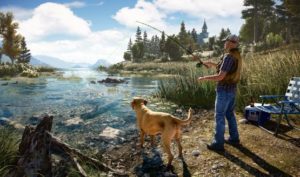 Co-op is back, and you can enjoy the game from start to finish with a buddy…but I found this to be rather pointless if your goal is to progress into the story. If you jump into a friend’s game, and unlock a bunch of map locations, do some quests and progress the story, none of your progress follows you back into your game, except money made and guns earned. Now I understand this in some ways, as it would not make sense to skip some of the story in your game if you played a bit further ahead in somebody’s else’s, but I feel more should have came over with you. Is it so hard to have map locations, side quests, and other little activities transfer over? In all honesty it made me never want to play with a friend. Sure it is a lot of fun causing chaos together, but the end just did not justify the means, and I found myself ignoring co-op requests when friends would reach out to me. I will say that doing simple activities like fishing and racing was a lot of fun with a partner though.
Co-op is back, and you can enjoy the game from start to finish with a buddy…but I found this to be rather pointless if your goal is to progress into the story. If you jump into a friend’s game, and unlock a bunch of map locations, do some quests and progress the story, none of your progress follows you back into your game, except money made and guns earned. Now I understand this in some ways, as it would not make sense to skip some of the story in your game if you played a bit further ahead in somebody’s else’s, but I feel more should have came over with you. Is it so hard to have map locations, side quests, and other little activities transfer over? In all honesty it made me never want to play with a friend. Sure it is a lot of fun causing chaos together, but the end just did not justify the means, and I found myself ignoring co-op requests when friends would reach out to me. I will say that doing simple activities like fishing and racing was a lot of fun with a partner though.
Far Cry 5 is a beautiful game. On a PS4 Pro or Xbox One X you will see the game really come to life in its 4k, HDR display. Few games capture nature like this game does, and hearing the sounds of the flora and fauna layered underneath the chaos and gunplay of the gameplay really creates a nice orchestra of different sounds and effects. Seeing the complete random nature of the world in these graphics have just been a breathtaking experience. In one situation I was hunting a very mad bear all hoped up on the before mentioned Bliss drug. The bear was quite the bullet sponge as it took many of my rifle rounds, only to run straight towards me, right past me, into a small fire, catching it on fire, only for it to run towards a nearby outpost, into the enemy filled area, and right up to an explosive barrel that 4 guys were standing next to, killing them and liberating the outpost. I was not even planning on taking down that outpost at this time. These random happenings are not foreign to the Far Cry series, but I have found that they happen more regularly, as if there is a chaos code in the background that just randomly generates unique moments that leave me audibly voicing my surprise or excitement.
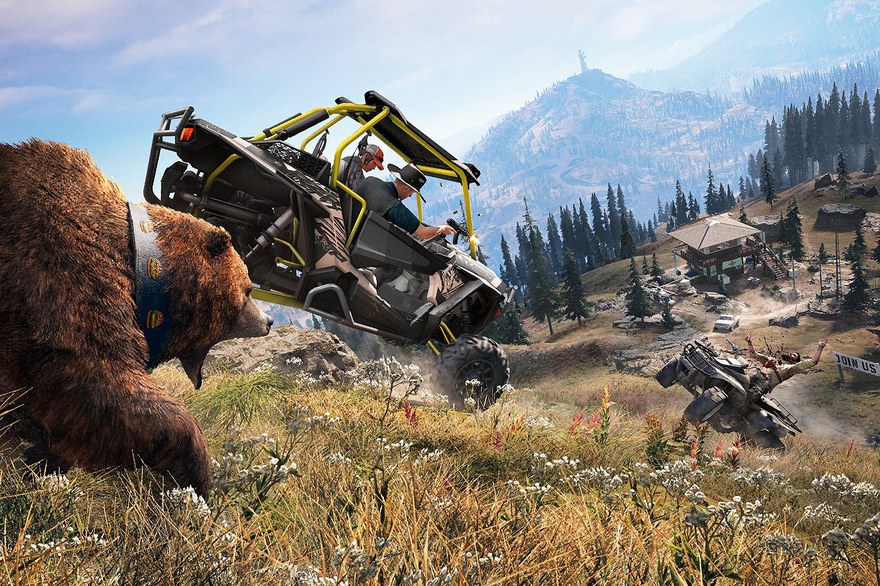
These teams did a wonderful job with Far Cry 5. I experience was a meaty one with plenty to do, leaving me with plenty of Owen Wilson style “wows” to be said. While it does not do much to change the standard Far cry formula that began in Far Cry 3, I changes up enough to not make it feel like a reskinned experience. Far Cry has never looked or felt better, and if you are a longtime fan of the series, this should be a no brainer purchase. However, if you are looking for a complete reinvention of the series, you may find yourself disappointed. There are not many games that offer up an experience quite like Far Cry delivers, and if you like open worlds and shooting bad guys, then you might want to saddle up for this trip into Montana.
Though a novelist at heart, London born author Richard K. Morgan has quite the resume, having taken a dip into different corners of the writing pool. In addition to writing the story for 2011’s Crysis 2 for noted video game publisher, Electronic Arts, Morgan has also gone a few rounds with Marvel’s spy extraordinaire, Natasha Romanoff, and is currently penning a fantasy trilogy starring a gay protagonist, a surprising rarity within the genre. We hopped on the chance to discuss these things as well as his current project, a digital gamebook of his 2008 fantasy series, A Land Fit For Heroes.
Kimi Britt: At what point did you make the decision that being a writer was something you wanted to do for the rest of your life?
Richard Morgan: Well, early enough that I can’t really remember making it! J K Rowling has a nice way of putting it – she said once in interview that ever since she was old enough to understand that there were people who made their living from writing stories, that was what she wanted to be. Same for me.
KB: Were there any specific works or authors who were some of your early inspirations?
RM: I think there was always a pretty even divide between my SF and Fantasy inspirations and then the stuff you could best designate, I guess, as hardboiled. Growing up, I was a huge fan of Michael Moorcock and Poul Anderson, with a side order of Bob Shaw. But at the same age – rather alarmingly – I was also tearing through Ian Fleming’s Bond and Leslie Charteris’s (original, written in the twenties and thirties) Saint books. Then, in the late seventies, just as I was hitting my teens, I came across William Gibson’s early short stories in Omni magazine and – wow! blam! critical mass! Because, of course, what Gibson had done in those stories was synthesise an alloy of exactly those two genre strands I loved so much – hardboiled noir and the finest speculative SF. I knew instantly that this – this! – was the kind of stuff I wanted to write myself.
KB: What rituals or habits did you adopt when you first started writing, and are they still prevalent in your everyday routine?
RM: Truth is I’m not good at ritual, and the way I write – exploratory, improvised, and painfully slow! – doesn’t lend itself to particularly good working practices. What I did in the early years was just dedicate every available hour of downtime I had to writing, whenever I could and wherever I was. And to be honest, that hasn’t changed all that much even now – it’s just that these days, with no day job to distract me, I have a lot more downtime available, so I get more done!
KB: With novels, comic books, and video games in your repertoire, you’re like a triple threat of the literary world. Was there ever a dramatic difference between these genres during the creation process? Are the three vastly different?
RM: Oh fuck yes – game writing and novel writing are about as far apart as it’s possible to get as creative processes. As a novelist, you’re intensely solitary; you sit in your room and type, you sit in your room and type – usually for a year or more, with no – or at best minimal – feedback until you turn in your draft. Game writing is the exact opposite – it’s intensely collaborative, team-based, fast and modular. You spend a lot of time in meetings, going back and forth to ensure you get a good fit with the other components of the game, and you tend to work in chunks – a cut scene script, a character sketch, a set of situational lines – and you get feedback – good and bad! – on those chunks very fast. You send an item out, get it signed off – or not! – and you’re done with it, so on to the next chunk. Also – this is more an attitudinal thing than a process issue – as a novelist, you know that what you’re writing is the whole thing, whereas in game writing, the work you do is essentially just a support framework for the main gig, which is the gameplay. You could write the finest game storyline ever, the best and sharpest in-game lines in the whole wide world, but if what you’ve done doesn’t gel with the rest, or worse still actually gets in the way of the gameplay, then you’ve failed. That’s a suitably humbling thing for a novelist to take on board.
Comicbook writing, I guess, is something of a midpoint between those two extremes – what you’re doing is the main gig, but it’s a main gig you share with the artist; comparing it with game writing, it’s like the difference between being the bass player in a four or five piece band and being the guitarist in one of those guitar and female vocal duos like the Kills or Mazzy Star. There’s a lot more conscious structuring involved than in novel writing – or at least than in the way I write a novel! – but it’s still largely about uninterrupted flow the way novel work is. If writing a novel is jazz, then writing a comicbook is perhaps more like rock and roll or the blues.
KB: Your sci-fi novel, Altered Carbon, is currently being developed for a movie adaptation. As the author of the source material, how much input do you have on that project?
RM: Generally speaking, when you get a movie deal, you take the money, hand the property over, and that’s about it. It’s rare for a novelist to be involved more deeply than that unless they’ve specifically held out for that involvement contractually, and I never have. My feeling is that when you give your book to someone to turn into the a movie, you need to be comfortable about getting out of the way and letting them work. Sure, you could always jump in and ask to learn the whole exciting process of moviemaking along the way, but is the best place to get that work experience really right bang in the middle of some seasoned film professionals’ attempt to turn your novel into a blockbusting movie? That said, the people I’m dealing with in this case – Laeta Kalogridis and Mythology Entertainment – have been really great about keeping me abreast of the process. And the way the contract is structured – this is something that was offered without my asking for it – once the movie is greenlit, I’m invited to come aboard as creative consultant, which should be a lot of fun.
KB: Some book to movie translations leave fans of the original work less than satisfied with the experience. Are you apprehensive about this prospect or does it feel like a natural progression?
RMl Yeah, there’s really nothing much you can do about that. What fans (and writers!) have to understand is that the movie is not the book, and never can be, it has to change in order to work, to live and breathe in such a radically different medium. What you’re aiming to capture is not the thing itself, but the spirit of the thing. And you’ve got to have faith in the people who’ve taken on the work of making that transformation happen (or at least be sanguine about it, if you’ve sold big for what you suspect will be a pretty crappy product :-) ). Like the old James M Cain quote goes – “People tell me, don’t you care what they’ve done to your book? I tell them, they haven’t done anything to my book. It’s right there on the shelf.”
In my case, I have every faith that the people who are working on Altered Carbon really want to honour the spirit of the novel, and however much my control-freak tendencies might pop and sizzle, I just have to let them get on with the job.
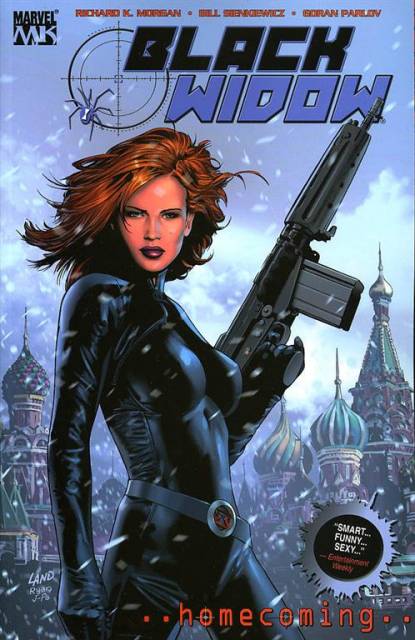 KB: With the influence you had on Black Widow’s characterization and how well the Avengers is doing, do you feel like she is accurately portrayed?
KB: With the influence you had on Black Widow’s characterization and how well the Avengers is doing, do you feel like she is accurately portrayed?
RM: Absolutely not, but what can you expect? I’ve said this before at length to Charlie Jane Anders over at Io9 – the Widow exists as an adjunct of a money-spinning superhero franchise catering to the tastes of 12 to 14 year old boys (and men who’ve somehow managed to grow up and retain a 12 to 14 year old boy heart). As such, she’s the epitome of unthreatening femininity grafted onto a pornstar’s T&A chassis and imbued with a set of plug-and-play boy-hero fisticuff character tics and reflexes. There’s nothing in that for women, nothing much in it even for genuinely grown-up males. The Widow I wrote for Marvel back in the early 2000s was her own woman, older, seasoned, hard as nails and unapologetic about it, centre stage in her own story. And let me tell you, that story flew like a fucking brick – the broad Marvel fanbase hated it. They didn’t like this genuinely empowered (and therefore genuinely feminist) female protagonist, and they voted with their wallets. The arc did disastrously low numbers by Marvel standards. So am I surprised by the version of the Widow that’s now emerged in the movies – hell, no! Just immensely saddened.
KB: Given the chance, would you ever want to return to continue her story?
RM: Are you fucking kidding! I’d love to. Writing Natasha, really letting her breathe, was a total blast! I’d jump at the chance to build a movie around her that did the same things Homecoming did. But there’s no way that’s ever going to happen. Don’t get me wrong, Marvel were great to work for; very professional, very supportive of what I was trying to do, and they really went out on a limb by letting me run with the character for a second arc when the first one had sold so dismally. But in the end, they killed the series for one very simple reason; it was a losing proposition – an expensive auteur project (I mean, we had Bill Sienkiewicz aboard, for Christ’s sake!), and doing dismally downward-spiralling numbers. By contrast, the version of the Widow you see in the movies is pulling in tens of millions of fanboy dollars. I mean, do the math – there’s just no way anyone’s going to let me within a mile of Natasha ever again! :-)
KB: Since you’ve had experience writing for both readers and gamers separately, the idea of bringing your dark fantasy series A Land Fit For Heroes to Steam, iOS, and Android as a gamebook is definitely intriguing to someone who enjoys both. How will a digital gamebook differ from the more traditional “Choose Your Own Adventure” type stories currently available? CYOA stories are typically made for a younger crowd, yet your series offers plenty of mature and controversial themes. Will these remain, and if so, how will they engage the player and the choices they make?
RM: That’s a question I’m not really qualified to answer – I never read the CYOA books back in the day, and I haven’t accessed any of the newer content either (these days I’m so busy I barely have time to read books or play games of any sort, let alone explore whole new formats!)
But my understanding from the brief the guys at Liber Primus have given me is that the vast majority of this stuff is YA-level in content. Land Fit for Heroes is avowedly not – it’s very much an adult fantasy, with adult themes and characters, and it’s as grim as anything I’ve ever written, which is saying something. So there’s that. :-)
 KB: How closely will the gamebook follow the existing story? Do players who have previously read the original have an advantage over newcomers to the series?
KB: How closely will the gamebook follow the existing story? Do players who have previously read the original have an advantage over newcomers to the series?
RM: The story in the gamebooks runs parallel to the main narrative in the novels – there’s some faint crossover with my characters in that some of them will make brief cameo appearances in the gamebook story, but the narrative thread itself follows three entirely new characters, and their adventures are disconnected from the storylines in the trilogy – though what they do and go through will be shown to have influence on the overall turn of events detailed in the novels. What this means for readers who’ve never read my stuff is that they’ll get a different initial angle of entry into my universe; but that won’t disadvantage them in any way as far as the gamebook story is concerned. And of course, if they’re curious about the wider world of the fiction, they can always go off and buy the trilogy after.
KB: What other projects are you currently working on?
RM: I’ve got a new novel up on the blocks at the moment – it’s a return to the universe of my 2007 novel Black Man, but set a good hundred or more years after the events of that story, and on a recently colonised Mars rather than on Earth. It’s called Thin Air and features another genetically modified cast-off protagonist, though a somewhat different and more down-at-heel one than Carl Marsalis in Black Man. I’ve gone right back to the noir wellspring I used in my Takeshi Kovacs books with this one – first person narrative, mean streets, corruption from high to low, a crime no-one wants solved and enemies at every turn. Feels good to be back behind the wheel of one of these!
KB: What sorts of media are you consuming in your spare time and would recommend?
RM: Not a whole lot of spare time to burn right now, I just moved from one end of the country to the other and I’m snowed under with busted deadlines. I am listening to quite a lot of music while I work, though; currently bingeing on 2 Cellos, Health and Cold Specks. And I just discovered an up-and-coming singer song-writer called Isaac Gracie whose single Last Words would make an awesome playout for a movie of my novel Market Forces. I just finished reading Ta-Nehisi Coates’ Between the World and Me, which I’d say is required reading for anyone interested in what’s happening to America at the moment and made me tremble with a father’s rage, and I’m now burning through John Horner Jacobs’ The Incorruptibles which is a superbly fresh-feeling mash-up of fantasy, alternate history and western adventure, the first of a trilogy whose second instalment, Foreign Devils, just came out – I’m running to catch up here! I’ve also been catching up on missed SF movies like Chappie and Ex Machina (both of which I guess I’d recommend seeing but neither of which in the end quite lit my fire) and more noirish fare like Scott Cooper’s Out of the Furnace and Dennis Lehane’s The Drop (both of which are awesome must-see triumphs). Still, sadly, waiting for someone in SF movie making – well, apart from George Miller, that is – to combine the vision and imagination in the former two with the close focus grit and commitment to human realities of the latter. In gaming, I’ve been making do with obsessive replays of The Last of Us, Max Payne 3 and Far Cry until there are enough good games out there to justify the expense of acquiring a next-gen console. At which point, I imagine I’ll be trying Bloodborne.
KB: Finally, where can you be found in various corners of the Internet?
RM: I keep a website at richardkmorgan.com where I try to find time and inspiration to blog at least once a month, and I’m on Twitter as @quellist1. Come on over!
Richard K. Morgan is the acclaimed author of The Dark Defiles, The Cold Commands, The Steel Remains, and Altered Carbon, a New York Times Notable Book that won the Philip K. Dick Award in 2003. A Land Fit For Heroes will be available on Android and ioS, as well as a PC version of the gamebook for Steam in the coming months.



